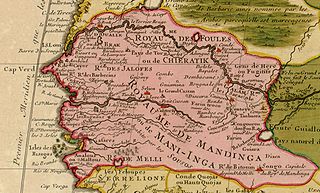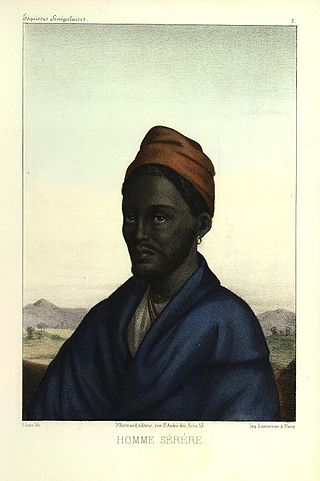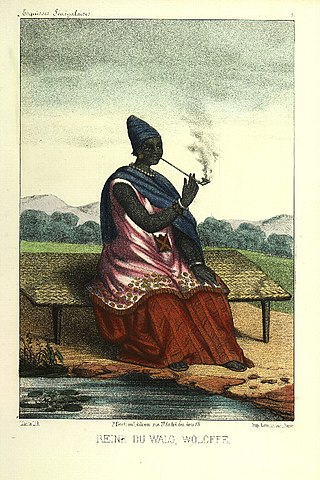
Cayor was from 1549 to 1876 the largest and most powerful kingdom that split off from the Jolof Empire in what is now Senegal. Cayor was located in northern and central Senegal, southeast of Walo, west of the kingdom of Jolof, and north of Baol and the Kingdom of Sine.

Baol or Bawol was a kingdom in what is now central Senegal. Founded in the 11th century, it was a vassal of the Jolof Empire before becoming independent in the mid-16th century. The ruler bore the title of Teigne and reigned from the capital in Lambaye. The kingdom encompassed a strip of land extending east from the ocean and included the towns of Touba, Diourbel, and Mbacke. It was directly south of the Kingdom of Cayor and north of the Kingdom of Sine.

Waalo was a kingdom on the lower Senegal River in West Africa, in what is now Senegal and Mauritania. It included parts of the valley proper and areas north and south, extending to the Atlantic Ocean. To the north were Moorish emirates; to the south was the kingdom of Cayor; to the east was Jolof.
Mö Mboj Maalik Mboj was the last King of Waalo prior to its fall to the French in 1855. The pre-colonial Kingdom of Waalo now lies within modern-day Senegal. The military conquest of Waalo in 1855 under Lingeer Ndate Yalla and her husband Tassé was one of many expeditions by the French colonialists in Senegambia but more so in Senegal. Moorish intervention in the political affairs of the Wolof Kingdom of Waalo propelled French military intervention, which led to the collapse of the royal dynasty and the disestablishment of the country. The conquered Kingdom of Waalo was by 1855, under French rule. Mö Mboj Maalik Mboj succeeded to the throne as Brak, ruling from 1840 to 1855. On his paternal line, he was a member of the reigning Mboj paternal dynasty of Waalo. On his maternal line, he partains to the Loggar matriclan. The Loggars were one of the three reigning maternal dynasties of Waalo, the other two being Joos and Tedyek.
The Kingdom of Sine was a post-classical Serer kingdom along the north bank of the Saloum River delta in modern Senegal. The inhabitants are called Siin-Siin or Sine-Sine.
Maad a Signig Kumba Ndoffene Famak Joof was the King of Sine in modern-day Senegal. Maad a Sinig means king of Sine. He ruled from 1853 until his death on 23 August 1871. He was the son of Maad Souka Ndela Joof and Lingeer Gnilane Jogoy Joof. His father – Maad Souka Ndela came from The Royal House of Semou Njekeh Joof founded by Maad Semou Njekeh Joof in the early 18th century, which was the third and last Royal House of Joof family of Sine and Saloum. His paternal family ruled three Kingdoms : Sine, Kingdom of Saloum and previously the Kingdom of Baol. They descended from Maad Ndaah Njemeh Joof the 13th century King of Lâ (Laah) in Baol.
Guelowar, also spelled Gelwar, Guelwar, Guelware, Gueleware or Gueloware, was a maternal dynasty in the pre-colonial Serer kingdoms of Sine and Saloum. They were from the Mandinka ethnic group. The offspring of Mandinka women and Serer men became the kings of Sine and Saloum. The dynasty lasted from the mid-14th century to 1969, the year both kings died.

Joof or Diouf is a surname that is typically Serer. This surname is also spelt Juuf or Juf.

Maad a Sinig Ama Joof Gnilane Faye Joof was a king of Sine now part of present-day Senegal. He reigned from c. 1825 to 1853. He was fluent in several languages. He came from The Royal House of Semou Njekeh Joof. Maad a Sinig means king of Sine in the Serer-Sine language. The term Bur Sine is also used interchangeably with the proper title Maad a Sinig or Mad a Sinig. They both mean king Sine. Bour Sine is usually used by the Wolof people when referring to the Serer kings of Sine. The Serer people generally used the term Maad a Sinig or Mad a Sinig when referring to their kings.

Teigne was the title of the monarch of the pre-colonial Kingdom of Baol, now part of present-day Senegal.
This is a timeline of the history and development of Serer religion and the Serer people of Senegal, The Gambia and Mauritania. This timeline merely gives an overview of their history, consisting of calibrated archaeological discoveries in Serer countries, Serer religion, politics, royalty, etc. Dates are given according to the Common Era. For a background to these events, see Roog, Serer religion, Serer creation myth, Serer prehistory, Lamane, States headed by Serer Lamanes, Serer history and Serer people.
Maad Ndaah Njemeh Joof is one of the patriarchs of the Joof family, himself the medieval King of Laah in Baol now part of independent Senegal. He ruled from the late 13th century to the early 14th century, c. 1290. His descendants from the branch of Maad Patar Kholleh Joof ruled the pre-colonial Kingdoms of Sine, Saloum and Baol, from the 14th century to 1969. The last king of Sine and Saloum died in 1969. After their deaths, the Serer States of Sine and Saloum were incorporated into independent Senegal. His descendants went on to found three royal houses:
Linguere Ndoye Demba Joos Fadiou, also known as Ndoye Demba in Senegambian dynastic history, was a Serer princess from the Kingdom of Sine, from the later half of the 14th century to the 15th century. The royal title – "Lingeer" means Queen or Royal Princess. She was given in marriage to the Brak of Waalo – Caaka Mbaar Mbooj. The surname Mbooj is the English spelling in the Gambia, variation include Mboge. In French speaking Senegal, it is spelt Mbodj. Differences in spelling is due to the colonial past of the Gambia and Senegal. France colonized Senegal, whilst Britain colonized the Gambia, thus the division of the two countries. Caaka Mbaar was the second king of Waalo from the Mbooj patrilineage, who ruled in the second half of the 14th century, around 1367. Brak was the title of the kings of Waalo. Lingeer Ndoye Demba was the founder of the Serer Joos Maternal Dynasty of Waalo. In the Wolof Kingdom of Waalo, Lingeer Ndoye Demba is considered the matriarch of the Joos maternal clan. In the Serer Kingdom of Sine, it is her grandmother Lingeer Fatim Beye who is considered to be the matriarch of this maternal dynasty. In the Serer language, the word "Fa-tim" means "the maternal clan of ... ". The Serer surname Beye is also one of the many Serer maternal clans.

Lingeer was the title given to the mother or sister of a king in the Serer kingdoms of Sine, Saloum, and previously the Kingdom of Baol; and the Wolof kingdoms of Cayor, Jolof, Baol and Waalo in pre-colonial Senegal. The word "Lingeer" means "queen" or "princess" in Serer and Wolof language. The Lingeer was considered the “great princess of royal courts.” These kingdoms utilized a bilineal system, as a candidate for kingship could not succeed to the throne if he was not a member of the reigning materlineage, and thus, the Lingeer's maternal lineage was highly significant. In similarity, a candidate could not succeed to the throne as king if he was not a member of the noble reigning patriclans. That was particular so among the Serer who retained much of their old culture, customs and traditional religion where women played a significant role compared to the Wolof who adopted Islam. Various Lingeers have been noted for their resistance efforts to colonial conquest.
Maad a Sinig Maysa Wali Jaxateh Manneh was a king described in the oral tradition of the Serer pre-colonial Kingdom of Sine and the first of the Guelowar maternal dynasty to rule in Serer country. He reigned as Maad a Sinig from c. 1350 to 1370.
The Royal House of Boureh Gnilane Joof was a royal house founded in the 14th century by Jaraff Boureh Gnilane Joof. He was a member the Serer tribe, from the pre-colonial Kingdom of Sine now part of independent Senegal. It was the first royal house founded by the Joof family during the Guelowar period. Boureh Gnilane Joof was a royal prince and a Jaraff, a Serer title of nobility with the powers of a prime minister. He was neither a Maad a Sinig nor a Maad Saloum but a royal prince who had the title Jaraff bestowed upon him by his cousin and brother-in-law - Maad a Sinig Diessanou Faye. His father Maad Patar Kholleh Joof was the king of Laa and Teigne of Baol. Boureh's brothers were the first from this house to have succeeded to the throne of Sine during the Guelowar period. His name was adopted in his honour to refer to the first royal house founded by the Joof family during this dynastic period. The Joof family of Sine, from this royal house also ruled in the Kingdom of Saloum The Joof family also ruled in Baol. From the date of its foundation up to the abolition of the Serer monarchies of Sine and Saloum in 1969, at least ten kings from this house had succeeded to the throne of Sine. As the first royal house of Sine founded by the Joof family in this dynastic period, the Royal House of Boureh Gnilane Joof holds great significance in Senegambian, Joof family and Serer history, because all the subsequent royal houses founded by the Joof family branched out from this royal house.

Lingeer Fatim Beye Joos Fadiou was a 14th-century Serer princess and queen (Lingeer) from the Kingdom of Sine. She is the matriarch and early ancestor of the Joos Maternal Dynasty of Waalo. She is usually regarded by some sources as the founder of the Joos Maternal Dynasty. The pre-colonial Kingdoms of Sine and Waalo now lies within present-day Senegal. Her surname is Beye (English-Gambia) or Bèye (French-Senegal). Joos Fadiou is her maternal clan. In Serer, "Fa-tim" means "the maternal clan of..."
Serer maternal clans or Serer matriclans are the maternal clans of the Serer people of Senegal, the Gambia and Mauritania. The Serer are both patrilineal and matrilineal. Inheritance depends on the nature of the asset being inherited – i.e. whether it is a maternal asset which requires maternal inheritance or paternal asset requiring paternal inheritance (kucarla). The Serer woman play a vital role in royal and religious affairs. In pre-colonial times until the abolition of their monarchies, a Serer king would be required to crown his mother, maternal aunt or sister as Lingeer (queen) after his own coronation. This re-affirms the maternal lineage to which they both belong (Tim). The Lingeer was very powerful and had her own army and palace. She was the queen of all women and presided over female cases. From a religious perspective, the Serer woman plays a vital role in Serer religion. As members of the Serer priestly class, they are among the guardians of Serer religion, sciences, ethics and culture. There are several Serer matriclans; not all of them are listed here. Alliance between matriclans in order to achieve a common goal was, and still is very common. The same clan can be called a different name depending on which part of Serer country one finds oneself in. Some of these matriclans form part of Serer mythology and dynastic history. The mythology afforded to some of these clans draws parallels with the Serer creation narrative, which posits that: the first human to be created was a female. Many Serers who adhere to the tenets of Serer religion believe these narratives to contain profound truths which are historic or pre-historic in nature.

Ndaté Yalla Mbodj, also known as Ndateh Yalla Mbooj, was the last great Lingeer (Queen) of Waalo, one of the four Jolof kingdoms in present day Senegal located in what is now North-West Senegal. During her reign, she fought against French colonization and Moorish invasion of her kingdom. In the 19th century,the Wolof queens Ndaté Yalla and her sister Ndjeumbeut Mbodj stood out as two of the most powerful women of 19th century Senegalese dynastic history.
Lingeer Ngoné Dièye was a Lingeer from the Serer Kingdom of Saloum, and ancestor of the Guedj maternal dynasty of Cayor and Baol. She was the wife of the 17th century Senegalese noble and Teigne Thié Yasin Demba Noudj Fall, and mother of Damel—Teigne Lat Soukabé Ngoné Fall who ruled Cayor and Baol from 1697 to 1719, the first Guedj to do so, after overthrowing the reigning maternal dynasty and installing his mother's matriclan. In usurping the throne, he committed fratricide by killing his paternal half-brother and took his throne.







